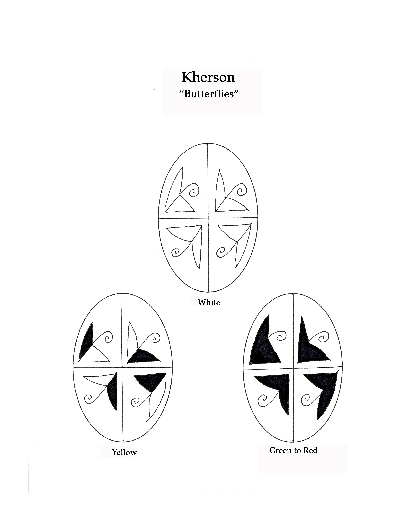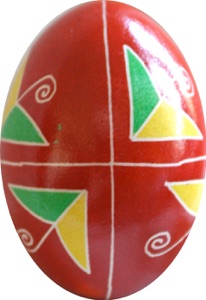Kherson
Херсонщина
Kherson
Херсонщина

This pysanka can be found in Binyashevsky’s book with the name «Ластівчині хвостики» (lastivchyni khvostyky, swallow tails). Onyshchuk included it in hers, and gave it the name of “butterflies.” Both of them have been known to give names to pysanky that did not have them in the original sources, and to change traditional names, but in this case Binyashevsky was accurate.
The earliest version, though is from Kulzhynskyi’s book, and he agrees with Binyashevsky. One can see the resemblance. To me it seems to resemble a “curl with wings,” or representation of the goddess (but not the dual version), but I have seen other sources describe this particular motif as a swallow's tail. Pysanky often changed their names over time, and most kucheri and goddesses have been given more modern names.


This pysanka was one of a set of three from the village of Blahodatne in the Kherson region. Kulzhynskyi describes them as having a brownish-red background, with designs in yellow and green. Based on the illustration he included (above, left), it was a very dark green, not the brighter green in later illustrations (e.g. Binyashevky, above right).
Kherson is located in southern Ukraine, in the vast and fruitful steppes. It is known today for its peppers (capsicums) and watermelons. Ethnographically, it is part of the Prychornomorya/Pryazovya region (Black & Azov Sea regions). It is an area that was settled later that the northern areas of Ukraine, after the dangers of nomadic marauders had been diminished, and has a rich kozak heritage.
Pysanky from this region are largely geometric, and often have a dark background color. Their level of complexity ranges from quite simple to moderate (although none approach those from the Hutsul regions).
Note: the download still has the incorrect name of “Butterflies,” because I created it before I was aware of the error.

Technical details: This is a fairly simple pysanka, except for the curls, which can be a challenge to beginners. It has a basic “Eight” division. As with most simple traditional designs, a medium or heavy stylus is best for the lines, and of course a heavy one for waxing in.
This pattern utilizes yellow, green, and red dyes. The green can be applied either by spot dyeing, or you can dye the entire egg green and then remove it with an orange rinse prior to coloring it red.
The line width in the example above should probably been a bit heavier. A traditional pysanka such as this, with a simple design, should have heavier (medium) lines.
Download this pattern sheet:
Back to MAIN Patterns page.
Back to MAIN Regional Pysanky page.
Back to MAIN Traditional Pysanky page.
Search my site with Google
Swallow Tails
Ластівчині хвостики
